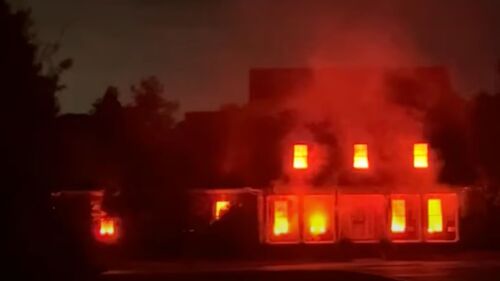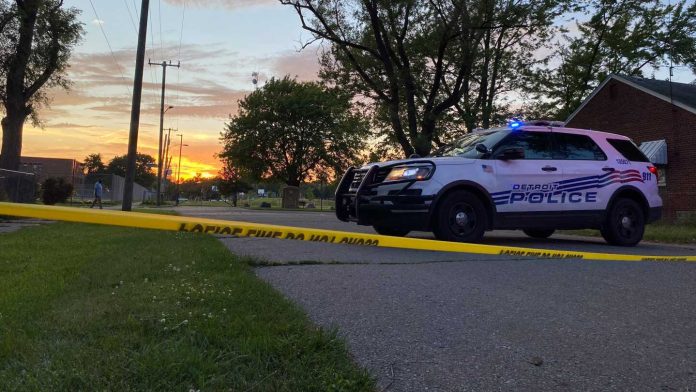By Ben Warren
The Detroit News
Thank you for reading this post, don't forget to follow and signup for notifications!
LANSING, Mich. — Violent crime dropped 5% across Michigan last year, driven by large declines in Detroit, Muskegon and Flint, which each reported steeper drops than the state as a whole.
Some cities that have historically struggled with the worst crime in Michigan are becoming safer, according to a Detroit News analysis of data from the FBI ‘s annual Uniform Crime Report, which collects law enforcement statistics from agencies across the country.
Police chiefs around the state and a criminal justice expert said strong community violence intervention and more officers on the street account for the change. At a Monday press conference, Detroit Mayor Mike Duggan and Police Chief Todd Bettison also credited technology, including the installation of Project Green Light cameras and the creation of the Real Time Crime Center, for the drop in carjackings and other violent crimes in the first nine months of this year.
One expert told The News that community engagement is key to maintaining the trend long term.
“We’re seeing not only in Detroit but in other large cities, large crime declines,” said Scott Wolfe, who directs the Michigan Justice Statistics Center at Michigan State University. “There’s something to be said to let good cops be cops, but they have to be working with communities.”
Despite the recent declines, Detroit remains one of the nation’s most violent big cities on a per-capita basis. The city’s nearly 1,800 violent crimes per 100,000 people in 2024 were second to Memphis among cities with populations greater than 500,000 people.
Where violent crime rose and fell
Most of the 43,615 violent crimes in Michigan occurred in the state’s largest cities: Detroit , Grand Rapids , Warren , Kalamazoo and Lansing rounded out the top five locations by the raw number of incidents.
But violent crime in each of those cities, except for Warren, has decreased over the last five years, according to the FBI data that was released Aug. 5. The largest decline has been in Detroit, where police reported 7.3% fewer violent crimes in 2024 than the year before, falling to more than 11,820 violent offenses and continuing a downward trend that stretches back to 2021.
Warren’s violent offenses rose almost 7% to 739 from 2020 to 2024.
Detroit accounts for about half of the state’s homicides each year. But from 2023 to 2024, the number of homicides fell from 250 to 203. Grand Rapids, which was second to Detroit in homicides in 2023, fell from 23 to 12 murders in 2024, behind Saginaw, Flint and Pontiac.
The three smaller cities among the top 5 for homicides are trending in the opposite direction: Murders rose 54% in Saginaw, 44% in Pontiac and 11% in Flint. Despite their smaller populations, each of the three cities had more homicides than Grand Rapids.
Saginaw’s homicide rate passed Detroit’s at 46.5 homicides per 100,000 people, compared with 38.7 homicides per 100,000 people in Detroit.
Data quality concerns have plagued the FBI crime statistics in past years, when major cities, such as New York, Los Angeles and Chicago, failed to report complete statistics, especially during an FBI transition from one reporting system to another. In Michigan, at least, the data is solid because law enforcement agencies representing most of the state’s population participate in the program, Wolfe said.
“UCR is one of the most relied-upon national or state-level crime stats. Not all agencies report, but we have pretty high reporting rates in Michigan,” he said. “You see large numbers of agencies report when there’s a clearinghouse like we have through MSP (Michigan State Police).”
The Michigan agencies that participate in the FBI crime reporting program represent about 94% of the state’s population.
The Trump administration has cited the crime rates in such places as Washington, D.C., Chicago and Memphis as reasons for deploying the National Guard to those cities. Illinois and Chicago leaders went to court Monday to try to stop the deployment there.
Detroit’s 1,781 violent crimes per 100,000 people ranked third among the top 200 cities by population, behind Memphis and Oakland. In comparison, Washington, D.C., had a rate of 926 violent crimes per 100,000 people in 2024, and Chicago had a rate of 540 violent crimes per 100,000 people, ranking Nos. 29 and 92, respectively.
Vice President JD Vance offered to send troops to Detroit in a speech last month in Livingston County after Republican U.S. Senate candidate Mike Rogers urged Detroit’s mayor to do the same thing earlier. Duggan spokesman John Roach pointed to declining violent crime in the city and said changing the city’s approach to reducing crime would be “a serious mistake.”
What’s behind the change
Wolfe, the criminal justice expert, and police departments across Michigan identified community violence intervention, increased officer staffing and the effective use of technology as key reasons why violent crime is down across the state.
“Our residents are the subject-matter experts of their own communities,” Wolfe said. Community policing does two things, according to Wolfe: “it gets information and it provides police with authorization to do their job.”
At the Monday press conference, Duggan said the city understands “we have to do more than arrest people” to fight crime. He said the city plans to prioritize community violence intervention when allocating the state funds it gets for crime programs; it would expand the program from 30 to 36 square miles.
One of the reasons cities like Detroit and Grand Rapids have been able to invest in these programs, Wolfe said, is that they have enough officers to provide basic services.
The Duggan administration reached agreements three years ago with its police unions to hand out an immediate $10,000 raise and increase salaries 4% for four consecutive years in a bid to stem an exodus of officers to surrounding suburban departments. Earlier this year, Bettison said the department was at nearly full staffing for the first time in many years.
When police departments aren’t fully staffed, Wolfe said, “fewer cops respond to calls for services and that erodes their trust.” He added that “it has a huge impact on proactive policing, you’re not getting out into the community.”
Policing technologies, such as license plate readers and gunshot detection software, can be effective when used correctly, Wolfe said.
He praised license plate readers as “a really good investigative tool,” but was more cautious about technology used by Detroit’s police department to identify gunshots via microphones in areas with high violent crime rates called ShotSpotter.
“ShotSpotter has gotten better about false positives,” Wolfe said, but “I think the verdict is still out. Time will tell.”
At Monday’s press conference, James Deir, the special agent in charge of Detroit’s arm of the U.S. Bureau of Alcohol, Tobacco, Firearms and Explosives, said ShotSpotter is a good tool that helps with law enforcement efforts.
Intervention makes a difference in Detroit
In Detroit, the ShotStoppers program has funded community violence intervention programs in six neighborhoods that experience some of the worst gun violence in the city.
“Our founder had this belief that people were not inherently violent, and that the criminalization and demonization of our communities wasn’t really sound,” said Dujuan (Zoe) Kennedy, executive director of FORCE Detroit, one of the community organizations receiving funding through the program.
“We believe that those closest to the problem are closest to the solution.”
FORCE provides mentoring programs, de-escalation counseling, basic needs assistance and cognitive behavioral therapy in the Warrendale-Cody Rouge neighborhood on the west side of Detroit. The organization also connects people impacted by violence with job training.
Their model is “pretty simple,” Kennedy said. “People know what goes on amongst their social networks. Now you have community members who are part of the conversation.”
More than half of the around 20 staff members at FORCE live in the community they serve, according to Kennedy, and 70% of them have ties to the area, most having grown up there.
“It’s all about relationships. It’s all about: How can I use my relationships to add to the quality of life in my community?” he said.
The ShotStoppers program, originally funded with $10 million from the American Rescue Plan Act, provides each of the groups with a base spending of $175,000 per quarter, with bonuses for reducing violent crime in their “zone,” a three- to five-mile area where they operate.
Crime data from the Detroit Police Department showed that the combined number of homicides and non-fatal shootings in the zone where Kennedy’s organization is focused fell 50% across the first two years of the ShotStoppers program.
During Monday’s press conference, Duggan said the collective efforts of these groups over the last four years helped to reduce homicides 40%, shootings 50% and carjackings 67%.
The mayor, who is running for governor as an independent in 2026, called the relationship between law enforcement and groups like FORCE “unlike any place in America.”
Kennedy said, “It’s a division of labor. We don’t get involved in their investigations, and they don’t get involved with our relationships.”
A ‘whole of city’ approach in Grand Rapids
On the west side of the state, Grand Rapids Police Chief Eric Winstrom said the city’s homicide numbers dropped dramatically last year because of “excellent detective work.”
But also crucial, he said, was putting enough uniformed officers on the street. When he started in 2022, Winstrom said, there was a shortage of officers, but the department now operates at full capacity.
The number of uniformed officers in the Grand Rapids Police Department has increased from 260 in 2022 to approximately 300 this year, according to the department.
The research mostly backs up the importance of staffing, Wolfe said. But more officers don’t necessarily mean less crime. When a department gets back closer to being fully staffed, he said, “It helps if they’re strategic about getting back to full capacity and doing things we know reduce crime.”
“It’s not just policing, but good policing that matters.”
For Winstrom in Grand Rapids, that meant taking a “whole of city approach,” working in tandem with the prosecutor’s office and community leaders.
“We are going to saturate this area with more police officers, but we know that’s not all we need to do,” said Winstrom, who became chief shortly before Patrick Lyoya was killed in April 2022 by a Grand Rapids officer whose second-degree murder trial ended in a hung jury. “We don’t want to be an occupying army.”
In particular, he said he advocated for more mentorship programs in the city. “When young people seek to get their love and affection from other youth committing crimes, that’s a very dangerous path.”
Beyond that, Winstrom said, “It’s basic things like fixing street lights, fixing basketball courts so kids have a place to play.”
The results have trended in the right direction since Winstrom took over in 2022; there were 7% fewer violent crimes and 40% fewer homicides in Grand Rapids in 2024 than two years earlier.
Ecorse PD relies on collaboration, technology
Not all police departments have the resources of Detroit and Grand Rapids . For the Downriver community of Ecorse, that means leveraging collaboration with nearby jurisdictions and increasing its use of technology.
Asked about his city’s notable 87% decline in violent crime, Ecorse Police Chief Jerry Flowers wrote in an email: “The crime drop can be attributed to re-assignment of personnel in our detective bureau, who are proactively gathering, using and sharing intelligence with other jurisdictions who are dealing with similar crimes and in some cases, the same suspects.”
Flowers told The News that joining River Rouge, Wyandotte and Lincoln Park as a member of the Downriver Central Dispatch “has had a positive effect in reducing crime in all our cities.” He said the program has allowed his department to put an extra officer on the street.
“We all work together because other cities are experiencing the same types of crimes, so they collaborate and exchange all types of information,” Flowers said.
There were 15 violent crimes reported in Ecorse last year, down from more than 100 in 2023, and no homicides in either year.
In the last two years, Ecorse has also begun to use gunshot detection technology from the company Flock Safety, which is better known for its license plate reader cameras, which Flowers’ department also uses.
The debate over ShotSpotter in Detroit is well-publicized. The city’s $7 million contract with the Fremont, Calif. -based technology company SoundThinking passed the City Council by just a single vote in 2022.
But Flowers’ take on using the tech is pretty simple: He said it helps his officers respond to gunfire even if people are afraid to call 911.
And the Flock license plate cameras, he told The News, help his department “identify suspects and suspect vehicles that are shared throughout a network of police agencies all over the state and country.”
Flowers said the technology is just auxiliary to his officers. “The officers are being held accountable to the citizens of our city, and are taking pride in being professionals,” he added.
Trending



Drones
Ohio launches statewide DFR program
The Drones for First Responders Pilot Program, a partnership with SkyfireAI and CAL Analytics, is intended to test and scale how drones can enhance situational awareness

©2025 The Detroit News. Visit detroitnews.com. Distributed by Tribune Content Agency, LLC.
Company News




